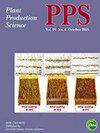在肯尼亚中部热带高地条件下,渗入NERICA1的与籽粒数量相关的基因(Gn1a和WFP)对籽粒产量的贡献
IF 1.3
3区 农林科学
Q2 AGRONOMY
引用次数: 0
摘要
摘要在肯尼亚和许多其他非洲国家,提高水稻产量对未来的粮食安全至关重要。为了提高肯尼亚的水稻生产力,通过将Gn1a和WFP引入肯尼亚注册品种NERICA 1中,开发了近等基因系(NIL)。这项研究的目的是确定这些基因的引入是否有可能提高肯尼亚中部热带高地条件下的水稻生产力。2016年和2017年,在肯尼亚姆韦阿的一块低地稻田,在不同的氮肥条件下,使用三个渗入Gn1a和/或WFP的NERICA 1品系(NIL-Gn1a、NIL-WFP和NIL-Gn1a+WFP)及其经常性亲本NERICA。两年的田间试验表明,渐渗系通过增加一、二级轴分枝数和每穗粒数来提高产量。Gn1a和WFP表现出加性效应,两个基因的渗入减轻了对渗入系中观察到的产量成分的负面影响,从而提高了粮食产量。单基因渗入系需要充足的氮肥才能提高产量。然而,即使在肯尼亚Mwea的低肥料条件下,与Gn1a和WFP的生产线也实现了合理的产量。由于这些渐渗系与其亲本品种具有相似的生长特征,预计它们将有助于肯尼亚和撒哈拉以南非洲类似环境的水稻产量增加。图形摘要本文章由计算机程序翻译,如有差异,请以英文原文为准。
Contribution of genes related to grain number (Gn1a and WFP) introgressed into NERICA 1 to grain yield under tropical highland conditions in central Kenya
ABSTRACT In Kenya and many other African countries, improving rice productivity is vital for future food security. To improve rice productivity in Kenya, near-isogenic lines (NIL) were developed by introducing Gn1a and WFP, genes that function to increase grain number per panicle by increasing secondary and primary rachis-branches, into NERICA 1, a registered variety in Kenya. The aim of this study was to determine whether the introduction of these genes has the potential to improve rice productivity under tropical highland conditions in central Kenya. Field experiments were conducted in 2016 and 2017 at a lowland rice field in Mwea, Kenya, under different nitrogen fertilization conditions using three lines of NERICA 1 introgressed with Gn1a and/or WFP (NIL-Gn1a, NIL-WFP, and NIL-Gn1a+WFP) and their recurrent parents, NERICA 1. Two years of field experiments revealed that the introgression lines enhanced grain yield by increasing the number of primary and secondary rachis-branches and the number of grains per panicle. Gn1a and WFP showed additive effects and the introgression of both genes alleviated the negative effects on yield components observed in the introgressed lines, resulting in higher grain yield. Sufficient nitrogen fertilization was required to increase yield in the single-gene introgression lines. However, the line with both Gn1a and WFP achieved reasonable yields even under low fertilizer conditions in Mwea, Kenya. As these introgression lines have similar growing characteristics to their parent variety, they are expected to contribute to increased rice production in Kenya and similar environments in sub-Saharan Africa. Graphical abstract
求助全文
通过发布文献求助,成功后即可免费获取论文全文。
去求助
来源期刊

Plant Production Science
农林科学-农艺学
CiteScore
5.10
自引率
4.00%
发文量
27
审稿时长
>36 weeks
期刊介绍:
Plant Production Science publishes original research reports on field crops and resource plants, their production and related subjects, covering a wide range of sciences; physiology, biotechnology, morphology, ecology, cropping system, production technology and post harvest management. Studies on plant production with special attention to resource management and the environment are also welcome. Field surveys on cropping or farming system are also accepted. Articles with a background in other research areas such as soil science, meteorology, biometry, product process and plant protection will be accepted as long as they are significantly related to plant production.
 求助内容:
求助内容: 应助结果提醒方式:
应助结果提醒方式:


